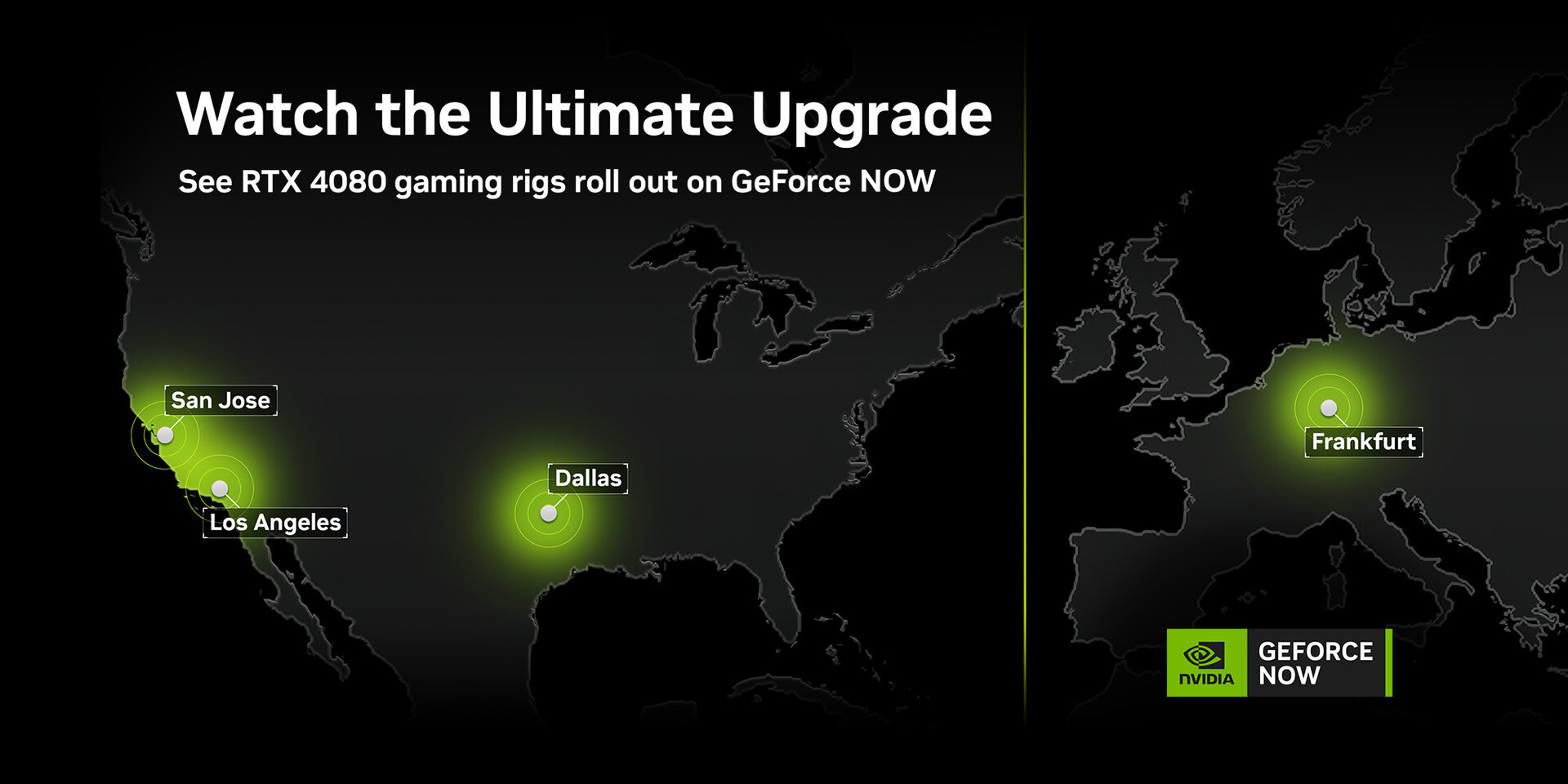Nvidia's data center at the Internet hub DE-CIX in Frankfurt am Main is one of four locations worldwide that already delivers the performance of a GeForce RTX 4080 (test) in the cloud. Nvidia announced GeForce Now Ultimate at CES. The new subscription replaces the old RTX 3080 tariff (test) at the same price.
The RTX 4080 in the cloud starts in Frankfurt am Main
At the presentation at CES 2023, Nvidia announced that GeForce Now Ultimate should be available gradually in the course of the first quarter of 2023. Comprehensive availability in the USA and Western Europe is not expected until the end of March 2023, but the first data centers should already offer the new option from the end of January. And now the time has come: The GeForce Now servers in San Jose, Los Angeles, Dallas and Frankfurt am Main are the first Nvidia data centers to have the new RTX 4080 SuperPods. Nearby GeForce Now customers can already access the subscription if they have purchased the Ultimate plan.

The price of the strongest GeForce Now subscription stays the same. Like the RTX 3080 tariff, GeForce Now Ultimate costs around 20 euros per month or around 100 euros for six months. GeForce Now RTX 3080 users will be automatically transitioned to the new tier and receive the higher performance once in-region data centers have been upgraded to the RTX 4080 SuperPods. From now on, however, the data centers that have not yet been converted should also be able to output in ultra-wide resolutions. Regardless of the subscription booked, there are also ten new games that will be available later this week via GeForce Now. In total, the cloud gaming service currently has over 1,500 games on offer, according to Nvidia.
- Farlanders (New on Steam)
- Surviving the Abyss (New on Steam)
- Tortuga – A Pirate's Tale (New on Epic Games Store)
- Epistory – Typing Chronicles (New on Epic Games Store)
- Absolute Drift (Steam)
- BLACKTAIL (Steam and Epic Games Store)
- Dwarf Fortress (Steam)
- Hello Neighbor 2 (Steam and Epic Games Store)
- NEBULOUS: Fleet Command (Steam)
- Shadow Tactics – Aiko's Choice (Epic Games Store)
Requirements for end devices and internet connection
GeForce Now Ultimate is fully available – at least for the time being – only via the macOS and Windows apps. The extended feature set can be accessed to a limited extent via Nvidia Shield and current browsers on Windows or Chrome OS devices. Smart TVs are also initially left out, even if they are models with a UHD 120 Hz panel. The official system requirements provide an overview of the various platforms. Dedicated guides also list detailed requirements and help with setup.
- Setup guide for Windows
- MacOS setup guide
- Nvidia Shield setup guide
- Android setup guide
- ChromeOS setup guide< /li>
These also show that Nvidia requires an internet connection with a downlink speed of at least 45 Mbit/s to stream 3840 × 2160 pixels at 120 FPS. The ping to the nearest Nvidia data center should also be a maximum of 80 ms, and less than 40 ms is recommended. The connection from the router to the end device should ideally be via an Ethernet cable connection; 5 GHz WLAN is mentioned as an alternative.
This is GeForce Now Ultimate
With GeForce Now Ultimate, Nvidia roughly offers the performance of a GeForce RTX 4080 via cloud gaming. Furthermore, with a new competitive mode, refresh rates of 240 Hertz are possible for the first time, with which the latency together with the Nvidia Reflex should drop to 34 ms, according to Nvidia. For the previous RTX 3080 tariff at the maximum possible 120 Hertz, Nvidia names a delay of 56 ms, while the editors came up with a minimum latency of 67 ms in the test.
If players on the streaming client output the image via a G-Sync monitor, GeForce Now also varies the streaming rate for the first time. There is no change in the maximum supported resolution – GeForce Now RTX 4080 also allows a maximum of 3,840 × 2,160 pixels – but UHD is now possible at up to 120 FPS or Hertz, whereas in the case of GeForce Now RTX 3080 there is still a limit of 60 FPS at UHD applied. Also new is the option to deliver an image adapted to ultrawide monitors with resolutions of, for example, 3,840 × 1,600, 3,840 × 1,440 or 2,560 × 1,080 pixels. The maximum frame rate in this case is also 120 FPS.
These are the RTX 4080 SuperPods
The RTX 4080 SuperPods for GeForce Now is a server unit that delivers the graphics power of a GeForce RTX 4080 from an Nvidia L40G. It is a modification of the Nvidia L40 server GPU presented in September, which was presented in September 2022. Both models are based on Ada Lovelace, specifically on an AD102 graphics chip with 142 active SMs and thus 18,176 FP32 execution units, which leads to a theoretical computing power of almost 90 TFLOPS with a boost clock of 2,475 MHz. Nvidia, on the other hand, speaks of 64 TFLOPS for an RTX 4080 SuperPod. In addition, an L40G has 24 GB of GDDR6 graphics memory.
For comparison: The GeForce RTX 4080 for the desktop can “only” do this with an FP32 computing power of 48.8 TFLOPS and 16 GB of graphics memory, but of the faster type GDDR6X. Ultimately, the performance provided by GeForce Now Ultimate should be comparable to the performance level of the desktop graphics card, Nvidia told ComputerBase. The differences in the theoretical raw performance can presumably be explained by lower clock rates and thus more economical operation.

